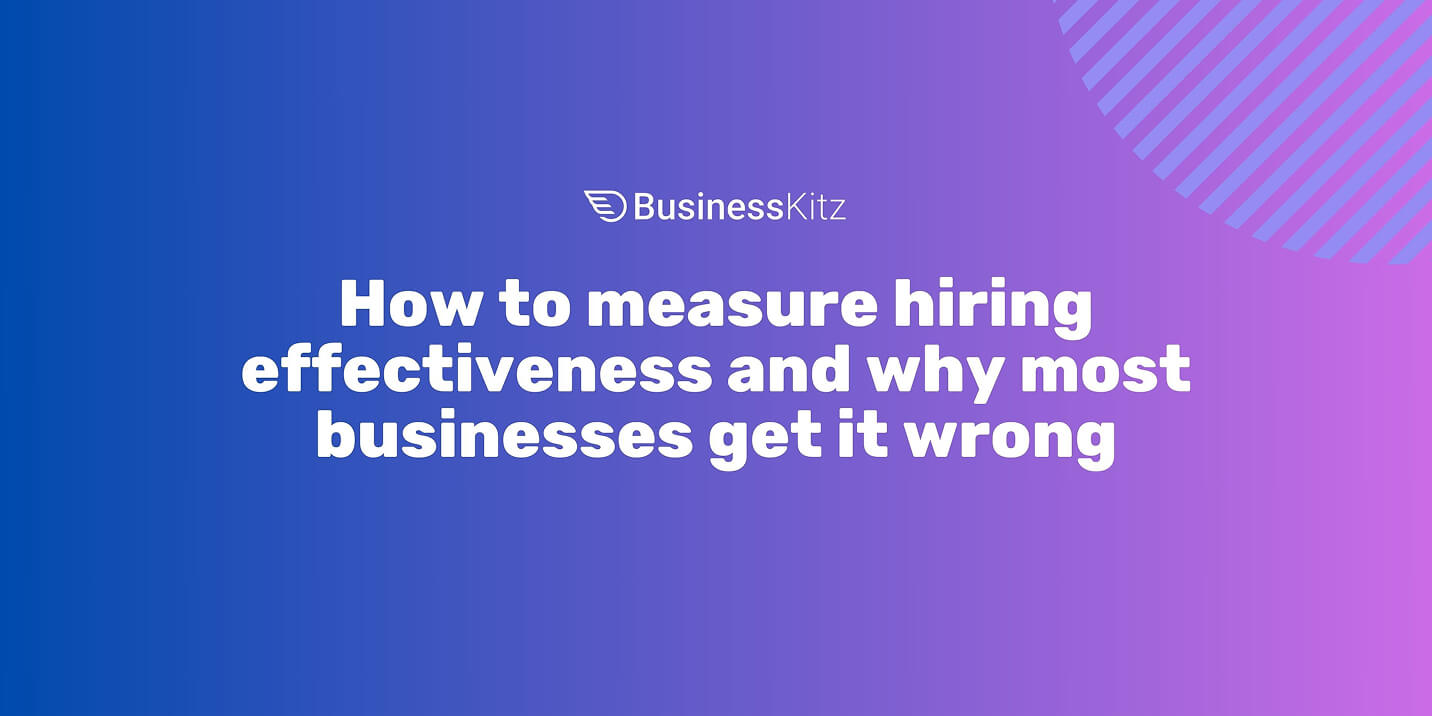
You've just spent six weeks filling a critical role, only to watch your new hire resign after three months. Sound familiar? You're not alone—research shows that companies take an average of 33-49 days to fill positions, yet many still struggle to determine whether their hiring process actually works. The difference between businesses that consistently attract top talent and those that don't often comes down to one thing: measuring what matters. Most SMEs focus on gut feelings and hope for the best, but data-driven hiring effectiveness can transform your recruitment from costly guesswork into a predictable system. Let's explore exactly how to measure hiring effectiveness and turn your recruitment process into a competitive advantage.
We've helped businesses save $55m with our all-in-one platform. Get instant access to this template and 115+ others, plus AI-powered document creation, starting completely free.
Hiring effectiveness measures how successfully your recruitment process identifies, attracts, and retains the right talent for your organisation. It goes beyond simply filling vacant positions—it's about finding candidates who excel in their roles, fit your company culture, and contribute to long-term business growth.
Think of it as the difference between hiring someone who merely shows up versus someone who drives real results. An effective hiring process delivers quality hires consistently while minimising time and costs. It creates positive experiences for candidates (even those you don't hire) and builds your employer brand.
Research indicates that measuring hiring effectiveness helps identify inefficiencies, reduce recruitment costs, and inform data-driven decisions about where to allocate hiring resources. Without proper measurement, you're essentially flying blind—hoping your efforts work without knowing what's actually driving results.
The key is understanding that hiring effectiveness isn't a single metric but a combination of quantifiable indicators that paint a complete picture of your recruitment success.

Before diving into complex calculations, let's identify the fundamental metrics that reveal whether your hiring process delivers results or drains resources.
These two metrics often get confused, but understanding the difference is crucial. Time to fill measures the total days from posting a job to accepting an offer, while time to hire tracks only the candidate's journey from application to acceptance.
Industry data shows the average time to fill is 41 days, yet 55% of candidates expect the process to take no more than two weeks from first interview to offer. This expectation gap highlights why tracking both metrics matters—lengthy processes lose top candidates to faster competitors.
Every hiring decision impacts your bottom line. Cost per hire encompasses all recruitment expenses divided by the number of hires made, including:
With the average cost per hire at $4,700, understanding your true costs helps justify recruitment investments and identify savings opportunities.
Despite being ranked as the most valuable metric by 39% of talent leaders, quality of hire remains notoriously difficult to measure. It reflects the value new employees bring to your organisation through their performance, cultural fit, and long-term contributions.
Common quality indicators include:
Nothing undermines hiring effectiveness faster than rapid turnover. This metric reveals the percentage of new hires who leave within their first year—a critical indicator of recruitment and onboarding success.
High turnover rates signal potential issues with job descriptions, interview processes, or company culture alignment. Each departure means restarting the expensive hiring cycle while disrupting team productivity.
Not all recruitment channels deliver equal results. Tracking where your best hires originate helps optimise resource allocation. Internal research shows that while internal candidates represent only 1.10% of applicants, they have a 45% success rate—the highest of any source.
Understanding the formulas behind recruitment metrics transforms raw data into actionable insights. Here's how to calculate the metrics that matter most for your hiring effectiveness.
Time to Fill = Date position filled - Date job requisition approved
Time to Hire = Date candidate accepts offer - Date candidate applies
Track these separately for different roles and departments to identify bottlenecks. For instance, technical positions typically take longer to fill than administrative roles.
Cost per Hire = (Total internal costs + Total external costs) / Number of hires
Revenue per Employee = Total company revenue / Total number of employees
Remember to include all costs consistently—leaving out employer branding or recruitment technology expenses skews your analysis and leads to poor budgeting decisions.
Quality of Hire = (Performance rating + Engagement score + Cultural fit score) / 3
Offer Acceptance Rate = (Number of accepted offers / Total offers made) × 100
New Hire Retention Rate = (Number of hires still employed after 12 months / Total hires) × 100
Source Quality = Number of hires from source / Total applicants from source
Application Completion Rate = (Completed applications / Started applications) × 100
Low application completion rates often indicate overly complex or lengthy application processes that deter qualified candidates.

Measuring metrics reveals problems—but fixing them requires strategic action. Here's how to transform your hiring effectiveness from average to exceptional.
Start by mapping each stage of your hiring process. Where do candidates drop off? Which stages take longest? Research suggests that interview efficiency should be at least 25-30% to maintain cost-effective hiring.
Quick wins include:
Stop wasting resources on underperforming channels. If LinkedIn delivers higher-quality candidates than generic job boards, reallocate your budget accordingly. Track not just quantity but conversion rates at each funnel stage.
Smart organisations use website analytics and source tracking to understand where their best performers originate, then double down on those channels.
Inconsistent interviews lead to poor hiring decisions. Develop competency-based questions tied directly to job requirements. Train all interviewers on unconscious bias and evaluation standards.
Create interview scorecards that measure specific skills and behaviours rather than relying on general impressions. This structured approach significantly improves quality of hire while reducing time to decision.
Your hiring process is often a candidate's first real interaction with your company culture. Poor experiences damage your employer brand and reduce offer acceptance rates.
Focus on:
Remember, rejected candidates talk about their experiences—positive or negative—influencing future talent pools.

Effective hiring isn't just about finding the right people—it's about managing the mountain of documentation that comes with each new employee efficiently. From employment contracts to onboarding checklists, poor document management can derail even the best recruitment strategies.
Speed matters in competitive talent markets. Our document signing feature enables instant digital signatures on employment contracts and offer letters. No more printing, scanning, or chasing paperwork—candidates can review and sign from anywhere, reducing your time to hire significantly.
The document vault becomes your single source of truth for all employee records:
Transform chaotic first days into smooth transitions with automated document workflows. Create standardised onboarding sequences that ensure every new hire receives:
Access our comprehensive template library featuring employment contracts, job descriptions, and HR policies designed. Each template is:
Our profiles feature consolidates all employee information in one accessible location. Track performance reviews, training records, and career progression alongside standard HR documentation—giving you complete visibility into your workforce effectiveness.
This systematic approach to hiring documentation doesn't just save time; it directly improves your recruitment metrics by reducing administrative delays and ensuring consistent, professional experiences for every candidate.
While there's no universal answer, quality of hire typically delivers the most valuable insights for long-term success. This metric directly correlates with business performance, employee retention, and team productivity. However, if you're just starting to measure hiring effectiveness, begin with time to hire and cost per hire—they're easier to calculate and provide immediate actionable data.
Review operational metrics like time to fill and source effectiveness monthly to spot trends quickly. Analyse quality-focused metrics such as new hire performance and retention rates quarterly, as they need time to develop meaningfully. Conduct comprehensive annual reviews comparing year-over-year performance and adjusting strategies based on findings.
SMEs actually have several advantages: faster decision-making, more flexible processes, and stronger cultural selling points. Focus on candidate experience, streamline your processes using digital tools, and highlight growth opportunities that larger corporations can't match. Measure what matters to your business rather than trying to replicate enterprise-level metrics.
Absolutely. Executive positions naturally take longer to fill and cost more than entry-level roles. Technical positions prioritise quality of hire over speed, while high-volume roles might focus on efficiency metrics. Segment your metrics by role type, seniority level, and department to gain meaningful insights rather than misleading averages.
For newly created roles without historical benchmarks, establish clear success criteria before hiring. Define specific outcomes, deliverables, or KPIs the role should achieve within 3, 6, and 12 months. Measure quality against these predetermined objectives rather than comparing to previous employees.
At minimum, you need an applicant tracking system (ATS) to capture basic data and a document management platform to handle employment paperwork efficiently. Spreadsheets work initially, but quickly become unwieldy as you grow. Integrated platforms that combine recruitment tracking with document management deliver the best insights while reducing administrative burden.
Measuring hiring effectiveness isn't about drowning in spreadsheets or chasing perfect metrics—it's about understanding what drives successful recruitment in your business and continuously improving those areas. You've learned which metrics matter most, how to calculate them accurately, and practical strategies to enhance your results. The businesses that thrive tomorrow are those that treat recruitment as a strategic function today, backed by data and streamlined by smart documentation processes.
Ready to take your hiring effectiveness to the next level? Sign up for a free trial with Business Kitz and discover how our document management tools can transform your recruitment efficiency today.
Copyright © 2025 Business Kitz 14312161